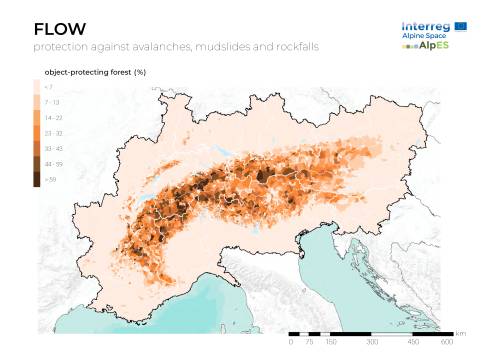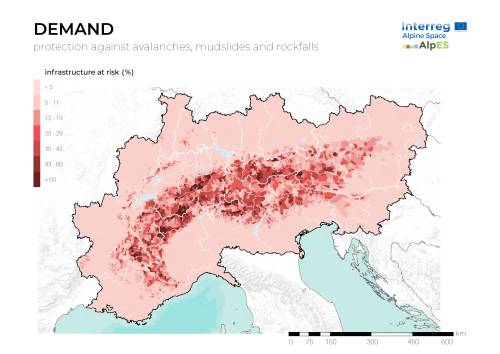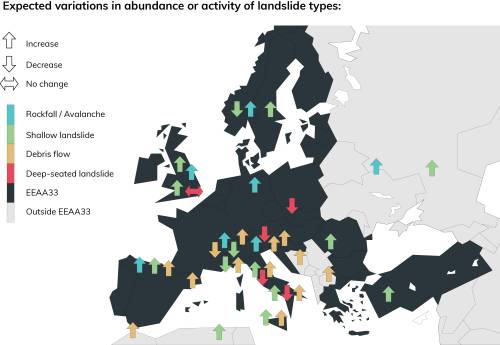Protection against avalanches, mudslides and rockfalls in the Alps
In mountainous areas characterised by considerable topographic variation and abundant ice, snow and water, one of the most important functions of forests is helping to prevent and mitigate rockfalls, mudslides, and avalanches. The Alps rank amongst the most forested areas in Europe, with about half of their area covered by woodlands.
However, not all forests have a protective function to people and human infrastructures. According to Brang et al. (2001), protective forests are identified by the simultaneous presence of (1) people or assets that may be damaged, (2) a natural hazard or a potentially adverse climate that may cause damage and (3) a forest that has the potential to prevent or mitigate this potential damage. This ES is of particular importance in many municipalities of the Alpine Space, where the topographic, geomorphologic and climatic conditions account for an elevated potential for natural hazard events. Accounting for this ecosystem service entails first defining all forests that have a mitigating function in natural hazards, whether or not there are “people or assets that may be damaged”. This way, total potential protection forests are accounted for. Next, only those forests
that fully meet Brang et al’s requirements are considered, in other words, object protecting forests. Finally, calculations are performed to determine exactly how much area of human infrastructure exists in danger zones, and thus requires some form of protection (whether or not it comes from forests). As climatic changes continue to ripple through the Alps, it is necessary for decision-makers to understand trends in these natural hazards and the role of forests in their mitigation. In this indicator set, only protection against avalanches and rockfalls, but not mudslides, was modeled. This is due to the complexity of this natural process, and the lack of suitable datasets for its modeling.
Supply

View this map in the AlpES webGIS
Protection forests are one of the most inexpensive and environmentally friendly mitigation approaches for natural hazards such as avalanches, rockfalls and mudslides. In fact, forests are cheap and self-sustaining, they require little or no management and they do not disrupt the landscape, unlike artificial barriers and protection systems.The map shows that the protection forest coverage is highest in the Alpine mountain range. This is explained by the very definition of protection forest, as those are the areas with the highest potential for gravitational hazards and mass movements, due to the slope of the terrain. Flat areas have a very limited potential for such types of natural threats, and therefore have little to no protection forest cover. Even in areas where there is no human infrastructure to protect, protection forests can be beneficial to counteract soil erosion, soften the impact of rain and reduce run off by water, thus contributing to the preservation of an intact and functional ecosystem.
Flow

View this map in the AlpES webGIS
Of all the potential protection forests mapped through the supply indicator, the flow indicator considers only those that have a direct protective function for human infrastructure,
like buildings, road networks and urban settlements. That is why the flow map shows a similar trend to that of the supply indicator. The hotspots in the map coincide with the
municipalities where villages have developed on or between mountainsides, nestled among the Alps. In these locations, forests play a key role in protecting municipalities from the steep slopes that surround, and threaten, them.The protective function of forests in the Alps has been recognized for centuries, as evident from logging bans declared from the 1350s onwards. The more recent Mountain Forest Protocol of the Alpine Convention of 1996 states that “mountain forests…provide the most effective, the least expensive and the most aesthetic protection against natural hazards”. As forest cover is constantly evolving, targeted silvicultural management strategies are needed to maintain or increase forests’ protective role (Berger et al., 2013).
Demand

View this map in the AlpES webGIS
The demand indicator for protection forests is calculated by considering two main factors: (1) the natural hazard potential, based on avalanche and rock-fall transition zones, and (2) the damage potential, which considers all human infrastructure (i.e. settlement areas, buildings, roads and railways). The intersection zones between these two areas identify all infrastructure that is located in potential hazard zones, and therefore is in need of protection. The map shows higher levels of demand in the Alpine mountain chain, where the natural hazard potential is high. In comparing the three maps for this ES, there is great consistency between the supply, flow and demand for protection forests. Indeed, there are only a few municipalities with high demand and low supply values, such as Saint-Martin-de-la-Porte or Hallstatt. These communities may receive high return on investment for planting protection forests in their jurisdiction. This relatively small amount of municipalities with a demand exceeding their supply does not necessarily imply that all potential danger zones are completely protected; protection forests may not offer absolute protection from every rockfall and avalanche event, and mudslides
were not included in these calculations. Climate change affects the stability of natural and engineered slopes; thus, it has important consequences on the frequency of rockfalls, erosion events and landslides. Recent research suggests that the increasing temperatures will lead to more frequent natural hazard events. Figure 3.7 shows
the expected variations in abundance of landslides due to climate change; these changes entail mostly increases of landslide activities across the Alpine Space and the rest of Europe. Furthermore, avalanches, storms, typhoons and other abnormal climate events are also likely to become more common, as a result of a rapidly changing climate.

<font 10px/inherit;;inherit;;inherit>Figure 3.7 Expected variations in the abundance of natural hazards due to climate change. Adapted from EEA, 2017.</font>